Ok it's taken me a while to get back- I took a heap of measurements of the mill and made some adjustments. Stand by for a pile of photos.
This is the type of cut I was making when I found the problem; with a face mill mounted in the NMTB40 horizontal spindle, I needed to take two passes across a workpiece by moving the knee in the Z-axis.
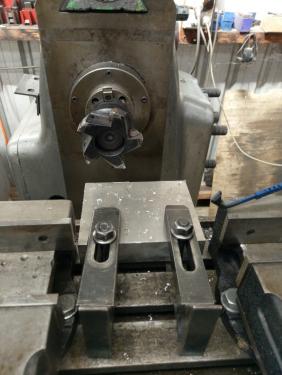
Because of the position of the cut on the workpiece and the width of the area to be machined, I needed to take two vertical side-by-side passes, I took one pass by raising the knee, then moved the table across in X and took the second pass by lowering the knee. The result was that the there was a step between the two cuts. I have done the same on this piece of aluminium just to demonstrate the problem I was having. You can see the step where the cuts overlap; I didn't measure it but it's not acceptable.
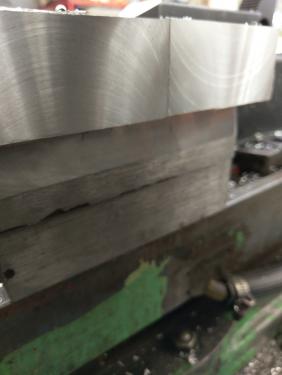
After my last post, I decided to take a heap of measurements on the machine to see where it was at. I took the vertical milling attachment off (wish it was as quick to install and tram that thing as it is to remove it) and set to with a DTI. Firstly indicating from the spindle to the column face to check how square the spindle is to the face. There is no way to adjust this.
Firstly with the arm short,
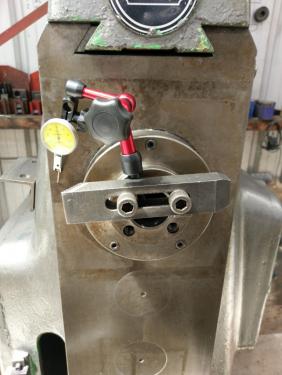
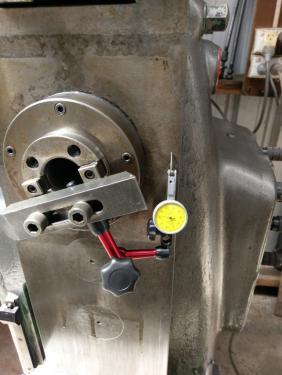
The face of the column here is a bit uneven from where the vertical attachment has been clamped on for decades. I extended the arm to indicate off a part of the column face that is not touched by either the vertical attachment nor the knee.
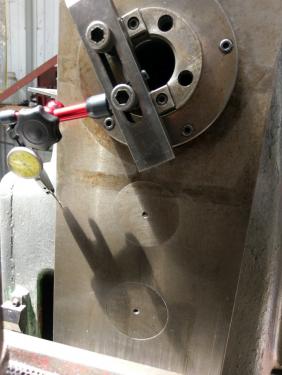
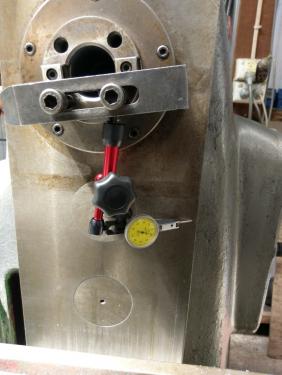
I got a reading of .024mm across a 210mm sweep. That's just under a thou in 8 1/4'. Good or bad, it is what it is.
I put a 1" horizontal milling arbor in the spindle, took readings around it to find the straight side and indicated off it to check the alignment of the Y-axis movement to the spindle axis.
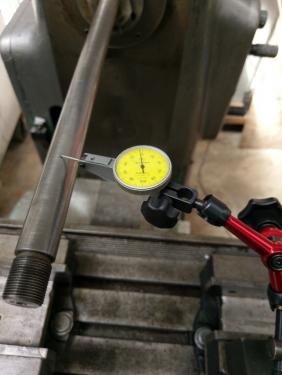
I took a reading along the top of the arbor to check the parallelism of these two axes in the vertical plane; result was pretty poor- 0.12mm in 200mm (.0047" in 8")
Indicating along the side of the arbor to check the alignment of the Y-axis to the spindle in the horizontal plane, a much more pleasing .004mm in 200mm (.00015" in 8")
I checked the spindle runout both on the inside taper and o the outside surface. Both were less than one increment on a .002mm DTI.
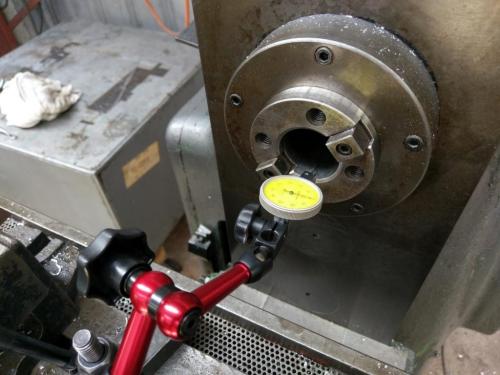
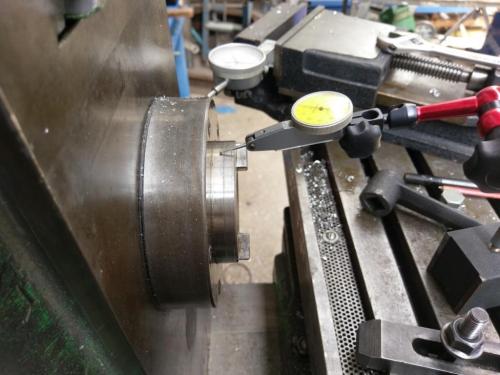
Knowing where the machine is at in these areas (I know I haven't checked straightness of any of the ways with these measurements), it seems to me that it is pretty good everywhere except for the sag in the Y-axis which will result in steps between parallel cuts when vertical milling along the X-axis but not in the step I'm getting between the Z-axis passes when stub milling.
I went through two procedures to align the table at 90 degrees to the spindle. Firstly by mounting an indicator on the table and passing it across the face of the column; it was .007" out initially from one side to the other. I adjusted the table and got it to .007mm (.00027") across the 210mm (8 1/4").
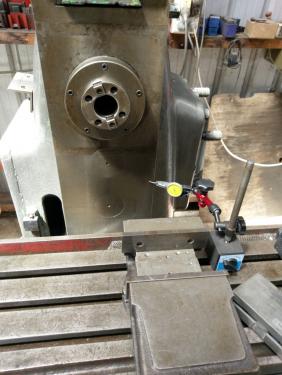
I took a test cut on that aluminium block passing the block across the face mill in the X axis. I was not happy with the result, no cross-hatching, the leading edge was cutting but the trailing edge of the cutter was clearing when I passed the table from left to right.
I decided to try the other suggested method of aligning the table- indicating from the spindle to the rear of the table. I was reluctant with this initially as the rear face of the table does not have the appearance of a precision surface- this is probably due to it being painted at least twice by the apprentices in the last 60 years; a bit of a cleanup revealed a better looking surface. I mounted a carpenters level to the spindle to provide a rigid arm (doesn't need to be straight, just rigid)
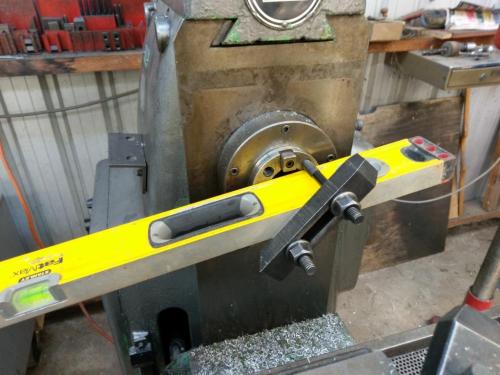
clamped an indicator on the outboard end and read off the back of the table at both ends by rotating the spindle 180 degrees.
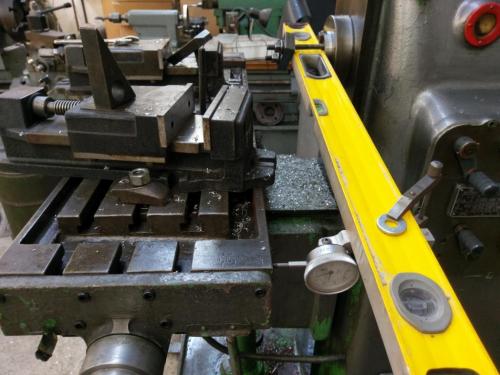
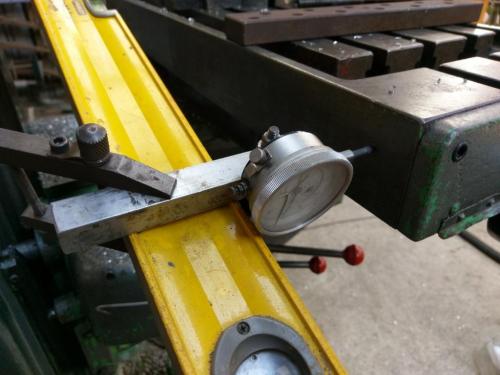
I didn't write down the initial reading but from memory it was about .007"; this is with a distance of 45" between the two ends of the swing. I adjusted it again, best I could get it was .01mm in 1140mm (.0004" in 45"). I called that near enough.
I mounted my test block of aluminium to the table again to take some test cuts. Firstly a couple of passes in the X-axis. Got a decent cross-hatched pattern which was encouraging- I didn't get a great finish but my machine can't spin this cutter fast enough for aluminium plus there was some built-up-edge on the inserts by the time I'd made the cut.
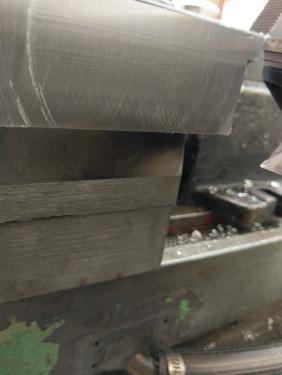
I moved the table in .020" and took two passes in the Z-axis; raised the knee for the first pass, moved across and lowered the knee for the second pass. I got the same problem that I started out with- a major step between the two cuts. That second photo at the top of this post is actually of this cut.
I decided to try attacking it a different way; taking both cuts with the knee moving downward. The knee is powered but I figured there is a fair bit of load to raise that knee and maybe that has something to do with it. I moved in another .020", took one pass with the knee going down, then went the long way around to get the cutter above the work and take the second pass with the knee also going down. The result was heaps better. Again, not a great finish, but there is no discernible step between the two cuts.
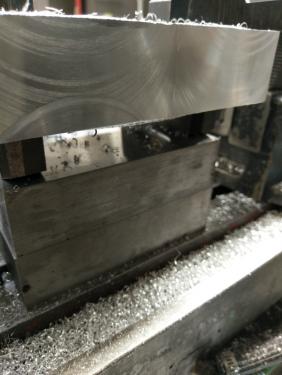
I was going to attach a close-up photo of that last cut but I've reached the limit per post.
I'm keen to receive any feedback or advice on this. The piece I was having the problem with is the overarm that I am mounting the j-head to for the frankenmill project. I need to cut a flat face on either side at one end to attach the cheek plates. The only way I could figure to mount the big overarm casting in the mill was parallel to the table which requires the surfaces to be milled in two passes in the Z axis.
Lathe (n); a machine tool used in the production of milling machine components.
Milling Machine (n); a machine tool used in the production of lathe components.





![[Image: TomsTechLogo-Profile.png]](http://tomstechniques.com/wp-content/uploads/2013/11/TomsTechLogo-Profile.png)
